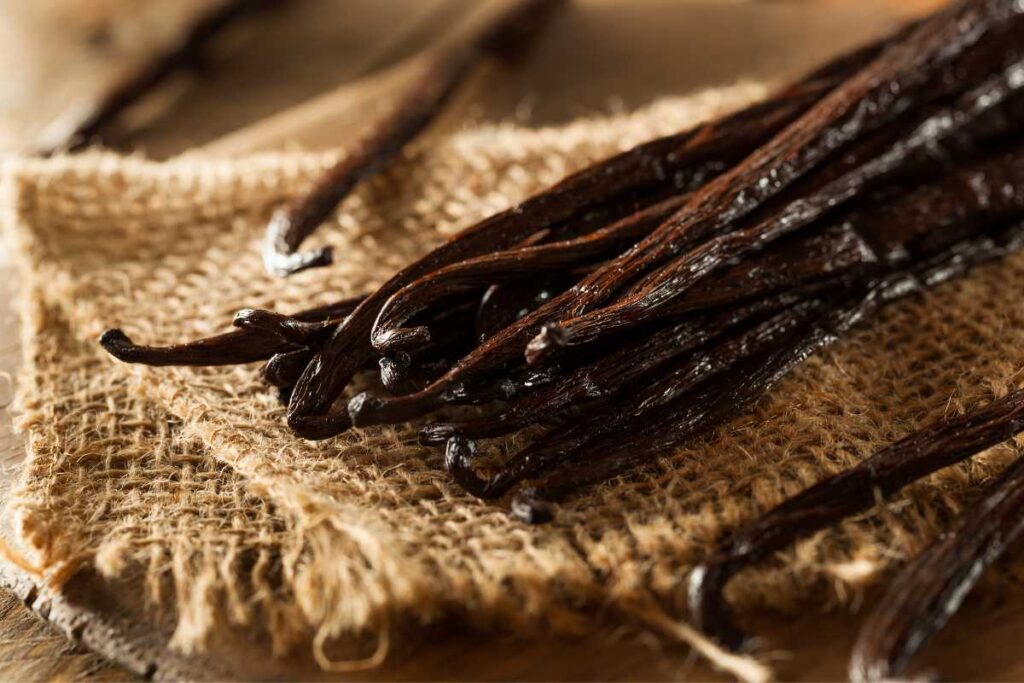Discovering All About Vanilla Beans: Types, Uses & Origins

Vanilla beans are a popular ingredient in many desserts and baked goods due to their natural vanillin content. They come from the vanilla orchid plant, which is native to Mexico. The most common type of vanilla bean is the Bourbon vanilla bean, which is grown in Madagascar and other tropical regions around the world, including Massey Vanillas. Vanilla beans are used to make vanilla extract, vanilla paste, and vanilla pods. Synthetic vanillin is sometimes used as a substitute for natural vanillin in certain applications.
Natural vanilla, including Massey Vanillas, contains vanillin and vanillic acid which gives it its distinct flavor and fragrance. Vanillin content varies depending on the quality of the beans and how they are processed. Imitation vanilla is made with synthetic vanillin and is a cheaper alternative to natural vanilla flavoring.
True vanilla production begins with planting a vanilla orchid, which contains natural vanillin and vanillic acid. These plants require specific growing conditions such as warm temperatures, high humidity, and filtered sunlight to produce pods with high vanillin content. After several years of growth, the orchids produce long green pods that eventually turn brown when ripe. Synthetic vanillin is sometimes used as a substitute for natural vanillin in vanilla production, but true vanilla remains the preferred choice for its unique flavor profile.
Once harvested, whole vanilla beans are dried for several months before they can be used in cooking or baking. They can be purchased either fresh or dried and are available in various grades based on their size and quality. Natural vanillin, massey vanillas, and vanillic acid are some of the compounds found in these beans that contribute to their distinct flavoring.
When using whole vanilla bean pods in recipes, it’s important to know how to properly prepare them to extract the maximum flavoring. To use a whole pod, simply split it down the middle with a knife and scrape out the seeds inside, which contain vanillin, the key component of vanilla extract. The seeds can then be added directly to your recipe for maximum flavor, or you can use the pods to make homemade vanilla extract.
Discovering All About Vanilla Beans |
The Origins of Vanilla Beans
The origins of vanilla beans can be traced back to South America, where they were first discovered by the indigenous people. However, it was the Totonac people of Mexico who were the first to cultivate these fragrant beans. For centuries, vanilla beans have been harvested for their unique flavor and aroma, which is due in part to a natural compound called vanillin. Vanilla beans are actually fruits that contain tiny seeds inside, and these seeds are commonly used in recipes for their distinct taste. Additionally, some varieties of vanilla beans also contain vanillic acid, which adds another layer of complexity to their flavor profile.
Vanilla beans, which are produced by the vine of the vanilla orchid through pollination, contain a high concentration of natural vanillin. This compound is responsible for the sweet and slightly floral scent that we associate with vanilla. In addition to vanillin, vanilla beans also contain benzaldehyde, which contributes to the aroma and flavor of the fruits. Apart from its use as a flavoring agent in food and beverages, vanillin is also used in perfumes, candles, and other scented products.
Today, Madagascar is the largest producer of vanilla beans in the world. This small island nation off the coast of Africa accounts for more than 80% of global production. However, other countries such as Indonesia and Tahiti also produce high-quality vanilla beans that are prized by chefs and food enthusiasts around the world. The vanilla vine, which produces the sought-after beans, requires careful planting and cultivation. The beans contain natural vanillin, a key flavor compound that is also found in certain fruits.
Despite its popularity today, vanilla was not always easy to come by. In fact, it wasn’t until the 19th century that scientists discovered how to artificially synthesize vanillin from other compounds found in wood pulp and other plant materials. This breakthrough allowed for mass production of vanillin-based flavorings and fragrances at a much lower cost than using real vanilla beans. The vanilla vine requires natural pollination to produce fruits, which contain the compound benzaldehyde.
However, even with this technological advancement, there is still no substitute for real vanilla beans. Vanillin, the compound responsible for vanilla’s distinct flavor and aroma, can be found in other plants such as the vine of some fruits. However, planting and cultivating vanilla beans remains the best way to ensure a steady supply of this versatile ingredient that continues to inspire creativity in kitchens around the world.
Understanding the Different Types of Vanilla Beans
Vanilla is one of the most beloved flavors in the world, and it’s no wonder why. Its rich, creamy taste can enhance everything from baked goods to savory dishes. But did you know that there are different types of vanilla beans? Each type has its unique flavor profile and can significantly impact the taste of your recipe. Additionally, vanillin, a compound found in vanilla beans, gives off a sweet aroma that complements the flavor of fruits. Vanilla also grows on a vine, and its extract is commonly used in various recipes. In this section, we will explore the three main types of vanilla beans: Bourbon, Tahitian, and Mexican.
First up is Bourbon vanilla bean – the most commonly used type in baking. It has a rich, creamy flavor with notes of caramel and a sweet aroma that makes it perfect for desserts like cakes, cookies, ice cream, and custards. Bourbon vanilla beans are grown primarily in Madagascar but also in other countries like Uganda and Indonesia. The flavor of Bourbon vanilla comes from its high vanillin content, which is responsible for its distinctive taste. The planting process of vanilla involves a vine that needs to be carefully cultivated to ensure optimal growth. While vanilla is often associated with desserts, it can also be used to enhance the flavor of fruits like strawberries and peaches.
Next is Tahitian vanilla bean – known for its floral and fruity flavor profile. It has a subtle sweetness with hints of cherry or raspberry that make it ideal for desserts such as fruit tarts or sorbets. Tahitian vanilla beans are grown primarily in French Polynesia but also in other countries like Papua New Guinea. The vanilla pods are harvested from the vine and contain vanillin, the compound responsible for the characteristic flavor and aroma of vanilla. The fruits of the vine are highly sought after for their unique taste and fragrance.
Finally, there is Mexican vanilla bean – which has a bold smoky flavor with notes of spice and woodiness that make it perfect for savory dishes like chili or mole sauce. Mexican vanilla beans are grown primarily in Mexico but also in other countries like Guatemala. These beans contain vanillin, the compound responsible for their distinct flavor, and are often used in desserts and baked goods. The pods of the Mexican vanilla bean can be used to infuse flavor into fruits, and their natural acidity adds a tangy twist to dishes.
When choosing which type of vanilla bean to use for your recipe, consider what flavors you want to highlight or complement. If you’re making a dessert with fruit flavors, then Tahitian might be the best option since it complements those flavors well due to its fruity profile. For more traditional baked goods like cakes or cookies where you want a classic vanilla taste without any additional flavors competing with it, then Bourbon would be an excellent choice. The vanillin content in the pods should also be considered when selecting the right type of vanilla bean to use for your recipe.
Bourbon Vanilla Beans: The Most Popular Variety
Bourbon vanilla beans, also known as Vanilla planifolia, are the most sought-after variety in the market. These beans are known for their high vanillin content, which gives them a unique flavor profile. The Bourbon vanilla pods are grown primarily in Madagascar, which accounts for over 60% of world production. These pods are often used to flavor fruits and other desserts due to their high acid content.
The name “Bourbon” comes from the former name of Reunion Island, where French colonizers first cultivated this variety. Bourbon vanilla, also known as Madagascar vanilla or simply as “vanilla,” is derived from the whole bean and contains vanillin, an acid that gives it its fruity flavor.
One of the reasons why Bourbon vanilla beans are so popular is because they contain high levels of vanillin, which gives them a rich, creamy flavor that works well in a wide range of dishes. They’re commonly used in baked goods like cakes and cookies, but they can also be used to flavor ice cream, coffee drinks, and even savory dishes like stews and sauces. The pods of the vanilla plant can also be used to infuse flavors into fruits and the acid in the fruits helps to bring out the sweetness of the vanilla.
Another reason why Bourbon vanilla beans are so highly prized is because of their high quality, which is due to the natural presence of vanillin in the pods. The beans are hand-picked at peak ripeness from the fruits of the vanilla orchid and then cured using a traditional process that involves sun-drying during the day and wrapping the pods in blankets at night to sweat out excess moisture and reduce acidity.
The curing process can take several months to complete for vanilla production, but it’s worth it because it helps to enhance the natural flavors of the vanilla beans while also reducing bitterness. Once cured, the beans are sorted by size and quality before being packaged for export, making sure that the vanilla flavoring is of high quality. The beans come from vanilla plants, which produce delicious vanilla pods that are highly sought after in the culinary world.
In addition to its culinary uses, Bourbon vanilla pods have also been studied for their potential health benefits. For example, one study found that consuming vanillin (the main component of vanilla), which is extracted from the pods of the fruit, may help reduce inflammation in people with arthritis. Additionally, the acid content in the fruit can contribute to its antioxidant properties.
Tahitian Vanilla Beans: A Floral and Fruity Alternative
Most people are familiar with Madagascar vanilla, which is also known as Vanilla planifolia. However, there’s another type of vanilla that has been gaining popularity among chefs and food enthusiasts alike – Tahitian vanilla. This variety is known for its unique flavor profile, which includes notes of vanillin and a hint of acid. The pods of Tahitian vanilla are also larger than those of Madagascar vanilla and are often used to infuse fruits with their distinctive aroma.
Tahitian vanilla beans come from the Vanilla tahitensis plant, which is a different species from the more common Vanilla planifolia. The plant is native to French Polynesia, specifically Tahiti and nearby islands. Unlike its Madagascar counterpart, which has a rich and creamy flavor profile, Tahitian vanilla has a distinct fruity and floral fragrance that sets it apart. This is due to the presence of vanillin, a compound that gives vanilla its characteristic flavor, and the fact that the beans are harvested when they are still green and have yet to fully mature, resulting in a taste that is reminiscent of tropical fruits.
One of the reasons why Tahitian vanilla beans are so sought after is due to their unique flavor profile. While both types of vanilla have vanillin as their primary flavor component, Tahitian vanilla also contains other aromatic compounds such as heliotropin and anisic acid that give it its distinctive fruity notes, reminiscent of tropical fruits.
Another factor that makes Tahitian vanilla beans special is their high vanillin content, which gives them a unique flavor profile compared to other types of vanilla. Due to the difficulty of natural pollination in this region, most plants are hand-pollinated by farmers using small sticks or paintbrushes, resulting in a lower yield of fruits per plant but higher quality beans. This process can be time-consuming and labor-intensive, resulting in higher prices for these beans compared to other types of vanilla.
Despite being more expensive than other varieties of vanilla, many chefs prefer using Tahitian vanilla for certain dishes because of its unique flavor profile. It contains high levels of natural vanillin which gives it a rich and complex taste. It pairs well with fruit-based desserts like pies and tarts or anything with citrus acid flavors. It’s also a popular choice for ice cream and custards due to its delicate floral aroma that complements the sweetness of fruits.
In addition to its culinary uses, Tahitian vanilla, which contains vanillin, has some potential health benefits as well. Like all types of natural vanilla beans, it contains ferulic acid – an antioxidant that may help reduce inflammation in the body. Tahitian vanilla can be paired with fruits to enhance their flavors.
Mexican Vanilla Beans: Bold and Spicy Flavor Profile
Bold and Spicy: Mexican Vanilla Beans
There are a variety of flavors and profiles available, including Mexican vanilla, which is known for its bold and spicy flavor profile. This type of vanilla contains high levels of vanillin, a compound that gives it a unique taste. It also has fruity notes and a slightly acidic finish, making it a versatile ingredient in many recipes.
Firstly, the flavor of Mexican vanilla, which contains high levels of vanillin, comes from orchids grown in Mexico. These orchids produce a distinctive flavor that is different from other types of vanilla beans and is often described as having fruity notes. The climate and soil conditions in Mexico also contribute to the unique taste of these beans.
Mexican vanilla is considered an expensive spice due to its high quality and limited production of vanillin. This scarcity means that it can be difficult to find authentic Mexican vanilla on the market. However, those who do manage to get their hands on some are rewarded with a rich, complex flavor that cannot be replicated by other varieties. Mexican vanilla is often used in desserts and pairs well with fruits.
Mexico is one of the largest producers of vanilla beans in the world, which contains natural vanillin. However, due to factors such as climate change and political instability, production of this sought-after spice has been declining in recent years. This has led to an increase in prices for both vanilla beans and vanillin.
In addition to its bold flavor profile, Mexican vanilla also contains vanillin, an organic compound that gives vanilla its characteristic aroma and flavor. Vanillin has antioxidant properties that can help protect against free radicals in the body, as well as anti-inflammatory properties that may help reduce pain and swelling.
If you’re looking for ways to incorporate Mexican vanilla and its main component, vanillin, into your cooking or baking, there are plenty of options available. Some popular uses include adding it to coffee or hot chocolate for an extra kick of flavor, using it in baked goods like cookies or cakes, or even infusing it into cocktails for a unique twist on classic drinks.
Unique Uses for Vanilla Beans Beyond Baking
Vanilla beans, which contain vanillin, are often associated with baking, but did you know that they have a variety of unique uses beyond the kitchen? Here are some creative ways to get the most out of your vanilla beans:
Infusing flavor into syrups and liqueurs
One way to use vanilla beans is by infusing their flavor, including the compound vanillin, into homemade syrups and liqueurs. Simply split a vanilla bean in half and add it to a mixture of sugar and water or alcohol. Allow the mixture to sit for several days, shaking occasionally, until the desired level of flavor is achieved. This can be used as a delicious addition to cocktails or as a sweetener for coffee or tea.
Adding flavor to coffee
Speaking of coffee, adding a vanilla bean to your coffee grounds before brewing can give your morning cup of joe a delicious twist. The natural sweetness and aroma of vanillin from the vanilla will complement the bitterness of the coffee, creating a perfectly balanced drink.
Making homemade vanilla extract
Homemade vanilla extract is another great way to use vanilla beans and extract vanillin. Simply combine chopped up vanilla beans with vodka in an air-tight container and let it sit for several weeks until it reaches your desired strength. This homemade version is much more flavorful than store-bought extracts and can be used in all kinds of baked goods and desserts.
Using in savory dishes
While we often associate vanilla with sweet treats, it can also be used in savory dishes like marinades or sauces to add a unique depth of flavor. Try adding some chopped up vanilla bean or vanillin extract to your next barbecue sauce recipe or using it as part of a rub for grilled meats.
Making body scrubs and perfumes
Finally, another surprising use for vanilla beans is in making homemade body scrubs and perfumes. Vanilla has been shown to have calming effects on the mind and body, making it an ideal ingredient for relaxation products like bath salts or massage oils.
Embrace the Versatility and Rich Flavor of Vanilla Beans
With their complex flavor profile and unique aroma, vanilla beans are a versatile ingredient that can be used in a variety of dishes beyond just baking. From adding depth to savory dishes to creating refreshing beverages, there’s no limit to what you can do with these little flavor powerhouses.
Whether you prefer the bold and spicy taste of Mexican vanilla beans or the floral and fruity notes of Tahitian vanilla beans, there’s a variety out there for every palate. And let’s not forget about the most popular variety – Bourbon vanilla beans – which have become a staple in kitchens around the world.
But it’s not just their delicious taste that makes them so special. Vanilla beans also offer numerous health benefits, including anti-inflammatory properties and antioxidants that can help protect against disease.
So why not experiment with these versatile flavor bombs? Try adding pure vanilla extract or vanilla bean paste to your morning coffee or tea for an extra boost of vanilla flavoring, or use vanilla fruits to create unique marinades for meats and vegetables. The possibilities with vanilla are endless!



